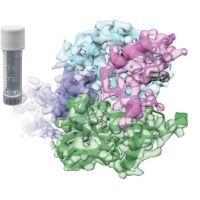Specification
| Description | Recombinant protein from the full-length sequence of Homo sapiens lin-28 homolog A (LIN28A) (NM_024674). |
| Organism | Homo sapiens (Human) |
| Expression Host | Human Cells |
| Tag Info | His or DYKDDDDK. Please contact us if you need further information or require specific designed tag. |
| Purity | Greater than 90% by SDS-PAGE gel |
| Uniprot ID | Q9H9Z2 |
| Entry Name | LN28A_HUMAN |
| Gene Names | LIN28A CSDD1 LIN28 ZCCHC1 |
| Alternative Gene Names | CSDD1 LIN28 ZCCHC1 |
| Alternative Protein Names | Protein lin-28 homolog A (Lin-28A) (Zinc finger CCHC domain-containing protein 1) |
| Application | Antigens, Western, ELISA and other in vitro binding or in vivo functional assays, and protein-protein interaction studies; For research & development use only! |
| Buffer | Purified protein formulated in a sterile solution of PBS buffer, pH7.2, without any preservatives |
| Endotoxin | Endotoxin level is < 0.1 ng/µg of protein (<1EU /µg) |
| Length | 209 |
| Molecular Weight(Da) | 22743 |
| Protein Sequence | (The sequence of expressed protein may have some variation from the sequence shown below. Please contact us for the exact sequence.) MGSVSNQQFAGGCAKAAEEAPEEAPEDAARAADEPQLLHGAGICKWFNVRMGFGFLSMTARAGVALDPPVDVFVHQSKLHMEGFRSLKEGEAVEFTFKKSAKGLESIRVTGPGGVFCIGSERRPKGKSMQKRRSKGDRCYNCGGLDHHAKECKLPPQPKKCHFCQSISHMVASCPLKAQQGPSAQGKPTYFREEEEEIHSPTLLPEAQN |
Background
| Function | FUNCTION: RNA-binding protein that inhibits processing of pre-let-7 miRNAs and regulates translation of mRNAs that control developmental timing, pluripotency and metabolism (PubMed:21247876). Seems to recognize a common structural G-quartet (G4) feature in its miRNA and mRNA targets (Probable). 'Translational enhancer' that drives specific mRNAs to polysomes and increases the efficiency of protein synthesis. Its association with the translational machinery and target mRNAs results in an increased number of initiation events per molecule of mRNA and, indirectly, in mRNA stabilization. Binds IGF2 mRNA, MYOD1 mRNA, ARBP/36B4 ribosomal protein mRNA and its own mRNA. Essential for skeletal muscle differentiation program through the translational up-regulation of IGF2 expression. Suppressor of microRNA (miRNA) biogenesis, including that of let-7, miR107, miR-143 and miR-200c. Specifically binds the miRNA precursors (pre-miRNAs), recognizing an 5'-GGAG-3' motif found in pre-miRNA terminal loop, and recruits TUT4 AND tut7 uridylyltransferaseS. This results in the terminal uridylation of target pre-miRNAs. Uridylated pre-miRNAs fail to be processed by Dicer and undergo degradation. The repression of let-7 expression is required for normal development and contributes to maintain the pluripotent state by preventing let-7-mediated differentiation of embryonic stem cells (PubMed:18951094, PubMed:19703396, PubMed:22118463, PubMed:22898984). Localized to the periendoplasmic reticulum area, binds to a large number of spliced mRNAs and inhibits the translation of mRNAs destined for the ER, reducing the synthesis of transmembrane proteins, ER or Golgi lumen proteins, and secretory proteins. Binds to and enhances the translation of mRNAs for several metabolic enzymes, such as PFKP, PDHA1 or SDHA, increasing glycolysis and oxidative phosphorylation. Which, with the let-7 repression may enhance tissue repair in adult tissue (By similarity). {ECO:0000250|UniProtKB:Q8K3Y3, ECO:0000269|PubMed:18951094, ECO:0000269|PubMed:19703396, ECO:0000269|PubMed:21247876, ECO:0000269|PubMed:22118463, ECO:0000269|PubMed:22898984, ECO:0000305}. |
| Pathway | |
| Protein Families | Lin-28 family |
| Tissue Specificity | Expressed in embryonic stem cells, placenta and testis. Tends to be up-regulated in HER2-overexpressing breast tumors. {ECO:0000269|PubMed:14688391, ECO:0000269|PubMed:15614775, ECO:0000269|PubMed:15722555, ECO:0000269|PubMed:22118463}. |
QC Data
| Note | Please contact us for QC Data |
| Product Image (Reference Only) |  |

